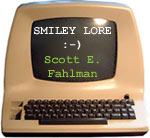Trudno dziś wyobrazić sobie komunikację (zwłaszcza w internecie) bez emotikon, znaków wyrażające emocje. Popularne symbole obchodzą właśnie 30 urodziny. Jak zaczęła się ich historia?
 Emotikony, zawdzięczające swą nazwę połączeniu słów „emocje” i „ikony” (a w innej wersji słowom „emotion” oraz „console”, czyli emocje wyrażane za pomocą konsoli) są graficzną reprezentacją psychicznych stanów osoby z nich korzystającej. Po raz pierwszy zostały użyte dokładnie 30 lat temu, we wrześniu 1982 r.
Emotikony, zawdzięczające swą nazwę połączeniu słów „emocje” i „ikony” (a w innej wersji słowom „emotion” oraz „console”, czyli emocje wyrażane za pomocą konsoli) są graficzną reprezentacją psychicznych stanów osoby z nich korzystającej. Po raz pierwszy zostały użyte dokładnie 30 lat temu, we wrześniu 1982 r.
Warto pamiętać, że nie są taką zupełną nowością. „Przodkowie” emotikon pojawiali się w alfabecie morsa (numer 73 wykorzystywany był jako komunikat „pozdrowienia”, a 88 – „całusy”) czy w prasie z końcówki XIX wieku. Dopiero jednak rozwój internetu pozwolił im zdobyć niezwykłą popularność.
Po raz pierwszy cyfrowa wersja emotikona została użyta przez Scotta Fahlmana z amerykańskiego Carnegie Mellon University w Pittsburghu. Na stronie uniwersytetu znaleźć można rozmowę, w której znaczek został użyty. Chodziło o określenie sytuacji żartu, potrzebę zaznaczenia, że dana kwestia ma zabarwienie humorystyczne.
Przytaczamy ją w oryginalnym brzmieniu:
17-Sep-82 14:59 Joseph Ginder at CMU-10A (*%)
I believe that the joke character should be % rather than *.17-Sep-82 15:15 Anthony Stentz at CMU-780G (*%)
How about using * for good jokes and % for bad jokes? We could even use *% for jokes that are so bad, they’re funny.17-Sep-82 17:40 Keith Wright at CMU-10A *%&#$ Jokes!
No, no, no! Surely everyone will agree that “&” is the funniest character on the keyboard. It looks funny (like a jolly fat man in convulsions of laughter). It sounds funny (say it loud and fast three times). I just know if I could get my nose into the vacuum of the CRT it would even smell funny!17-Sep-82 17:42 Leonard Hamey at CMU-10A {#} (previously *)
A detailed (i.e. > 1 minute) study of the aesthetic and pictographic effects of the characters available in the ASCII set has led to the following suggestion:
I think that the joke character should be the sequence {#} because it looks like two lips with teeth showing between them. This is the expected result if someone actually laughs their head off. An obvious abbreviation of this sequence would be the hash character itself (which can also be read as the sharp character and suggests a quality which may be lacking in those too obtuse to appreciate the joke.)17-Sep-82 18:52 Jim Crowley at CMU-10A BB Jokes
BB jokes are fine and should not require a marker. But jokes should not be malicious, obscene, or such that they appear to resemble real warnings to all but a few. Last nights elevator hoax was a borderline case of this last type.18-Sep-82 20:40 Guy Steele at CMU-10A ! Joke markers again
I hope everyone realized that my previous remark about non-use of joke markers was a joke, and was flagged as such by the absence of a marker. This message is not a joke, as indicated by the exclamation point.19-Sep-82 11:44 Scott E Fahlman :-)
From: Scott E Fahlman
I propose that the following character sequence for joke markers:
:-)
Read it sideways. Actually, it is probably more economical to mark things that are NOT jokes, given current trends. For this, use
:-(
Emotikony są dzieckiem rodzącego się internetu. Dziś jednak stały się integralną częścią języka, którym komunikujemy się na co dzień – także poza siecią.
Wpisy promowane
- Jak ubiegać się o kredyt dla firmy?Firmy nierzadko napotykają kłopoty finansowe, w których potrzebują dodatkowego wsparcia. Co więcej, większe kwoty, które nie zawsze są w posiadaniu ...
- Na co zwrócić uwagę przy kredycie hipotecznym w 2024 roku?Marzysz o własnym mieszkaniu, ale nie masz wystarczających środków finansowych? To właśnie wtedy z pomocą przychodzi kredyt hipoteczny, czyli jedno ...
Wydarzenia
Brak Patronatów
Najnowsze wpisy
- BaseLinker Index: Wzrosty sprzedaży online w marcuAnalitycy platformy BaseLinker– największego w regionie CEE systemu do zarządzania i automatyzacji sprzedaży online – opracowali właśnie najnowszy odczyt BaseLinker ...
- Packeta Poland: Analiza polskiego rynku e-commerce w branży modyW ostatnich latach polski rynek e-commerce w branży mody przeżywa dynamiczny rozwój. Według danych statista.com, liczba zamówień online w tej ...
- W lutym e-sklepy IdoSell rosły szybciej niż rynekSklepy internetowe, które korzystają z usług IdoSell, rosną znacznie szybciej niż rynek e-commerce w Polsce. Tak wynika z danych Grupy ...
- Dłuższy luty zwiększył sprzedaż – nowy raport BaseLinkerAnalitycy platformy BaseLinker– największego w regionie CEE systemu do zarządzania i automatyzacji sprzedaży online – opracowal najnowszy odczyt BaseLinker Index. ...
Zapoznaj się z ofertą wpisów promowanych oraz zasadami udzielania patronatów.
